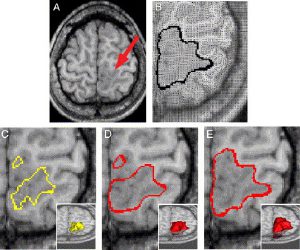Abstract
Focal cortical dysplasia (FCD) is the most frequent malformation of cortical development in patients with medically intractable epilepsy. On MRI, FCD lesions are not easily differentiable from the normal cortex and defining their spatial extent is challenging. In this paper, we introduce a method to segment FCD lesions on T1-weighted MRI. It relies on two successive three-dimensional deformable models, whose evolutions are based on the level set framework. The first deformable model is driven by probability maps obtained from three MRI features: cortical thickness, relative intensity and gradient. These features correspond to the visual characteristics of FCD and allow discriminating lesions and normal tissues. In a second stage, the previous result is expanded towards the underlying and overlying cortical boundaries, throughout the whole cortical section. The method was quantitatively evaluated by comparison with manually traced labels in 18 patients with FCD. The automated segmentations achieved a strong agreement with the manuals labels, demonstrating the applicability of the method to assist the delineation of FCD lesions on MRI. This new approach may become a useful tool for the presurgical evaluation of patients with intractable epilepsy related to cortical dysplasia.

